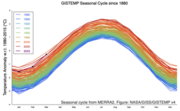BaCCC/Module 1/Lesson 2/Part 3
What is global warming (or global heating)?
In Lesson 1, you learnt that some people use the terms “global warming” and “climate change” interchangeably. What is the difference between climate change and global warming? Watch this video to learn the difference:
You can adjust the playback speed and/or turn on subtitles/captions.
If you have trouble accessing the video, a summary is available below.
H5P Object Parameters
The H5P parameters below will be replaced by the actual H5P object when it's rendered on the WordPress site to which it's been snapshotted.
Global warming (or global heating) is attributed to the enhanced greenhouse effect. This is caused by the increased concentration of greenhouse gases in the atmosphere. Greenhouse gases, such as carbon dioxide, methane and nitrous oxides, act like a blanket (an electric blanket, and we keep turning up the heat) and trap heat inside the Earth’s atmosphere, thus causing global warming. In the video, you learnt that global warming has been taking place since 1880. The graph below shows the global temperature anomaly (the deviation from what had been normal) since 1880. Take note of when the temperature started rising up. Also, what might have caused the spike in temperature in the late 1930s and early 1940s?
Study the diagram below that illustrates the global temperature anomaly since 1880.
| Feedback |
|---|
| Research shows that the 1930−40s spike can be attributed to the rise in greenhouse gases “as industrialized cities and nations continued burning coal to power factories and trains,” perhaps as the world was industrializing to pull itself out of the Great Depression (1929−1939) (Upton, 2016). |
The graph below is a totally different way of visualising the temperature anomaly (increase) since 1880 from a seasonal perspective. Note that the temperature anomaly is greater (a wider spread in the bands of colour) in the winter months than in the summer months in the Northern Hemisphere. In other words, winters are warming even more than summers, which has an impact on snowfall, and hence freshwater availability.
According to Australia’s National Science Agency, “there is no record of temperature having increased as rapidly as it has over the past century.”
The following sums up what you have learnt about global warming.
| United Nations COP26 (2021) presentation slide (adapted) |
|---|
|
| Increased Greenhouse Gas Concentrations | Increased Temperatures | Human Activities: Burning Fossil Fuels, Deforestation, Synthetic Fertilisers, Industrialised Livestock |
| Enhanced Greenhouse Effect | Incoming Solar Radiation | Heat Absorbed by Land and Sea |
| Atmosphere | Global Warming | |
| Radiation Reflected Back into Space | Greenhouse Effect | Solar Energy |
Now that you know the process of global warming, let us find out if there are any visible signs of global warming that you know of. Do the next activity based on the resources you have been learning from.
| Feedback |
|---|
|
1. Signs of global warming
2. In your local area, you may have observed or experienced extreme weather events, such as heavy and erratic rainfall, hailstorms and heatwaves. 3. Sea level rise is caused primarily by two factors related to global warming:
4. If global temperatures continue to increase, oceans will also be facing the ecological challenges of ocean acidification and deoxygenation. At the same time, fragile marine ecosystems, such as coral reefs, are also under threat. 5. Global warming speeds up (energises) the water cycle.
|
References
- ↑ Climate Central, 2023.Scientists trace climate−heat link back to 1930s



